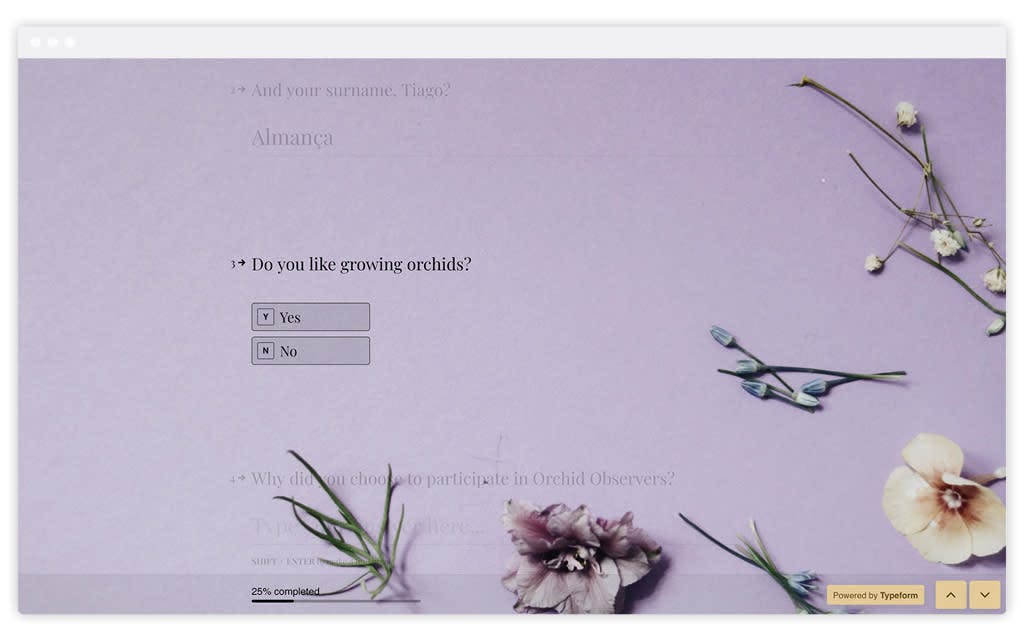Skip to content
How to create a survey
 Typeform | Make your next market research survey count with these 9 tips
Typeform | Make your next market research survey count with these 9 tips
https://www.typeform.com/blog/guides/market-research-survey-tips/
1. Give your market research survey purpose and context
Every market research survey should have one purpose—so what’s the objective of your survey? Why should someone go through the trouble of taking it?
Is it to get feedback on a new product or feature? Is it to learn why someone churned and left you for someone else? Do you want to gauge a person’s experience with your customer success department?
Stick to one purpose.
This brings us to context. Now that you know why you’re doing a survey, think about where and when they might be completing it. Are they in the office or at home? Are they doing it on the weekend or on a bus ride to work?
2. Tie survey incentives to your product but be wary of cash incentives or gift cards
There’s nothing worse than spending a lot of time answering survey questions only to see that nothing’s been done.
3. Talk to your ‘ideal reader’
4. Quality over quantity
Ryan Levesque author of
makes a case for response quality over quantity. Ryan clocked over $100 million in revenue from 23 different markets applying his survey funnel strategy. His surveys help him uncover profitable markets, develop products, and write engaging copy that comes right out of the survey-taker’s mouth.Ryan recalls an experience he had entering the “orchids” business. In the first survey he sent to his potential ‘orchid’ market, he asked the following question: what’s your biggest challenge when it comes to growing orchids?
The answers came pouring in, but then he noticed something. Many of the responses centered around ‘watering’ orchids. When should I water orchids? How often should I water them?
So what did Ryan do? He built an information product around watering orchids. Ryan used the most commonly used phrases for his marketing campaign, set up his website, and was ready for cash to rain from the heavens. But it flopped.
What happened? Ryan explains that he should have paid attention to quality of responses, not quantity. What turns out to be the best response to an open-ended question (what’s your biggest challenge?) is depth, not the quick one-sentence answer.
Why? Ryan suggests that if someone invests a lot of time explaining a particular problem, then they’re more invested in solving it. There’s a goldmine hidden in longer, more thoughtful responses. Ryan adjusted, put those quality answers into various buckets, prioritized them, developed another product, and the money rolled in.


5. Be conversational
Before you conduct your next , think about this. You’re on this planet with 7 billion other people. To create value in the world, your job is simple—help improve someone’s quality of life. In the end, business and life are about one thing:
Relationships.
You hear words like empathy, community, and caring far more in business than you do in your everyday interactions with others. George Anders on Linkedin predicting that empathy will be the number one job skill in 2020. He’s wrong: is the number one skill in business today—forget about 2020.
The internet makes it easy to connect with others en masse, but don’t mistake a shallow connection (such as Facebook ‘likes’) for deeper, more meaningful connections. The business world , and it’s . Your business thrives based on the depth of your connection with every client, customer, and human you engage with. (Don’t really care for the term ‘user’.)
Deep connections = increased loyalty.
How do you create deeper connections through a survey? Be conversational.
Even in a survey, don’t bore them with academic vernacular (like using words such as ‘vernacular’). Speak the common language, with common phrases and questions.
If you’ve been listening to your customers, if you communicate with them in their language and within their context, then you should have no trouble coming up with the right language or the right .
6. Don’t call it a market research survey
I know. It sounds contradictory, but if you sent out a survey and received less responses than you expected, try calling your survey something else. Using the word ‘survey’ brings up a range of thoughts.
How long will this take? What’s in it for me? Is this even relevant?
Instead of giving out a survey, ask for someone’s opinion. Ask for advice. Ask for some feedback. Give them a
.Play with different terms if you find your response rate low. It makes a difference.
7. Get micro-commitments
When you send out your survey, you want respondents to get involved quickly. So throw them a softball. Start with a simple yes/no, easy, can’t-miss question to get them going.
Are you a business owner?
Do you like growing orchids?
Have you ever been to Barcelona?


You get the idea. Think of it like a date. When you meet someone for the first time, you start with small talk. You don’t begin by telling them that you’re a 40-year-old virgin still living with mom—do you? You also wouldn’t have your date come to your house the very first time you meet (well, some creeps would). Make people feel comfortable. Get them involved early on. Gain trust—then ask the tough questions.
8. Remember: growth is your goal
You designed something. A product, a service, a curriculum, a thought-provoking article. Cool. But keep in mind: this is not your best work.
It doesn’t matter if you’re a startup or if you have global —you have not produced your best work yet. Your business always has and this gives you something to aspire to.
If you truly understand that your best work is yet to come and that you don’t have all the answers, then you will start from a place of humility. This kind of attitude will reflect in any communication you send out to potential or current customers, and will likely increase engagement, especially when it comes to surveys.
And what are surveys for again?
Surveys are tools for understanding people—so you can make things better or make better things for them.
Remember that. You’re asking people for their point of view so that you can learn from them. Your duty is to use that information to make different decisions and necessary adjustments. Your goal is to grow.
If you’re ready to do great work, and give your customers the best experience you possibly can, then you’ll need their honest feedback. So before designing your next survey, ask yourself:
Want to print your doc?
This is not the way.
This is not the way.

Try clicking the ⋯ next to your doc name or using a keyboard shortcut (
CtrlP
) instead.